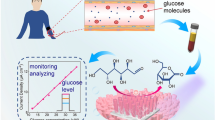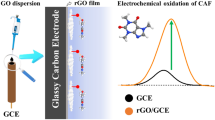Abstract
There has been substantial interest in designing and fabricating electrochemical non-enzyme sensors for glucose detection with a focus on the nanocomposites used between metal oxide and the two-dimensional material. In this work, Co3O4/reduced graphene oxide (rGO) nanocomposite was obtained and used as a modified electrochemical electrode for the detection of trace glucose. According to the results, the electrocatalytic performances of Co3O4 nanoparticles for the oxidation of glucose were substantially enhanced with the addition of a small amount of rGO. Specifically, the Co3O4/rGO modified electrode exhibited a sensitivity of 82 μA·mmol−1·cm−2, a detection limit of 50 μmol·L−1 (signal noise ratio (S/N) = 3), and a fast response time of about 1 s under optimal conditions. The enhanced performances of the Co3O4/rGO modified electrode are attributable to the high absorption oxygen (OAds) and synergistic effect between Co3O4 and rGO. The results indicate that Co3O4/rGO nanocomposite is a promising candidate for being used as the active material in real-world electrochemical biosensors.
Graphical abstract

摘要
葡萄糖为人体细胞能量的主要供应来源,对人体健康起着至关重要的作用。低血糖和高血糖都会危害人体健康,甚至危及生命,精确测量人体内葡萄糖水平对人体的健康管理至关重要。目前,葡萄糖浓度通常使用葡萄糖氧化酶电极进行测量,该方法中氧化酶在电极上的固定化过程非常复杂,而且酶在温度、湿度和pH值的影响下容易失去活性,导致检测结果失效。因此,灵敏度高、电极制备简单、稳定性好、性价比高的无酶类电化学传感器被认为是非常有前景的血糖检测候选器件。目前,用于葡萄糖检测的无酶类电化学传感器材料主要为金属氧化物,尤其金属钴氧化物材料,因为钴原子在碱性环境中具有高效催化氧化特性。但氧化钴材料活性位点少、导电性差,电催化活性较弱。本工作,制备了Co3O4/rGO纳米复合材料,复合材料中的石墨烯能够显著提高材料的导电性。其次,石墨烯在高温煅烧时的还原作用,使得Co3O4纳米颗粒表面产生较高吸附氧位点,在葡萄糖检测过程中提供了更多的反应活性位点。由于Co3O4与还原氧化石墨烯之间的协同效应和表面高吸附氧(OAds), Co3O4/rGO电极表现出较高检测灵敏度(82 μA·mmol−1·cm−2),低检测极限(50 μmol·L−1 (S/N = 3)),较快响应速度(~1 s)。结果表明,该复合材料是一种很有应用前景的电化学生物传感器活性材料。





Similar content being viewed by others
References
Pu F, Miao H, Lu W, Zhang X, Yang Z, Kong C. High-performance non-enzymatic glucose sensor based on flower-like Cu2O-Cu-Au ternary nanocomposites. Appl Surf Sci. 2022;581:152389. https://doi.org/10.1016/j.apsusc.2021.152389.
Dhiman P, Kumar A, Shekh M, Mechdihasan S, Gaurav S, Garima R. Robust magnetic ZnO-Fe2O3 Z-scheme hetereojunctions with in-built metal-redox for high performance photo-degradation of sulfamethoxazole and electrochemical dopamine detection. Environ Res. 2021;197:111074. https://doi.org/10.1016/j.envres.2021.111074.
Jin X, Li G, Xu T, Su L, Yan D, Zhang X. Fully integrated flexible biosensor for wearable continuous glucose monitoring. Biosens Bioelectron. 2022;196:113760. https://doi.org/10.1016/j.bios.2021.113760.
Dong Q, He TX, Zhang Y, Yang L, Huang K, Jiang X, Xiong X. One-step synthesis of Mn3O4@ZIF-67 on carbon cloth: as an effective non-enzymatic glucose sensor. Microchem J. 2022;175:107203. https://doi.org/10.1016/j.microc.2022.107203.
Zhao Z, Li Q, Sun Y, Zhao C, Guo Z, Gong W, Hu J, Chen Y. Highly sensitive and portable electrochemical detection system based on AuNPs@CuO NWs/Cu2O/CF hierarchical nanostructures for enzymeless glucose sensing. Sens Actuators B Chem. 2021;345:130379. https://doi.org/10.1016/j.snb.2021.130379.
Zhao J, Zheng C, Gao J, Gui J, Deng L, Wang Y, Xu R. Co3O4 nanoparticles embedded in laser-induced graphene for a flexible and highly sensitive enzyme-free glucose biosensor. Sens Actuators B Chem. 2021;347:130653. https://doi.org/10.1016/j.snb.2021.130653.
Puttananjegowda K, Takshi A, Thomas S. Silicon carbide nanoparticles electrospun nanofibrous enzymatic glucose sensor. Biosens Bioelectron. 2021;186:113285. https://doi.org/10.1016/j.bios.2021.113285.
Wang Q, Xue Q, Chen T, Li J, Liu Y, Shan X, Liu F, Jia J. Recent advances in electrochemical sensors for antibiotics and their applications. Chin Chem Lett. 2021;32:609. https://doi.org/10.1016/j.cclet.2020.10.025.
Wei H, Xue Q, Li A, Wan T, Huang Y, Cui D, Pan D, Dong B, Wei R, Naik N, Guo Z. Dendritic core-shell copper-nickel alloy@metal oxide for efficient non-enzymatic glucose detection. Sens Actuators B Chem. 2021;337:129687. https://doi.org/10.1016/j.snb.2021.129687.
Kumar A, Suneesh PV, Nair BKG, Babu ST. Complete fabrication of a nonenzymatic glucose sensor with a wide linear range for the direct testing of blood samples. Electrochim Acta. 2021;395:139145. https://doi.org/10.1016/j.electacta.2021.139145.
Lu ZJ, Cheng Y, Zhang Y, Wang X, Xu P, Yu H, Li X. Non-enzymatic free bilirubin electrochemical sensor based on ceria nanocube. Sens Actuators B Chem. 2021;329:129224. https://doi.org/10.1016/j.snb.2020.129224.
Lu Z, Zhang Y, Sun M, Zou P, Wang X, Wang Y, Huang Q, Chen H, Ye J, Rao H. N-doped carbon dots regulate porous hollow nickel-cobalt sulfide: high-performance electrode materials in supercapacitor and enzymeless glucose sensor. J Power Sour. 2021;516:230685. https://doi.org/10.1016/j.jpowsour.2021.230685.
Li G, Wen D. Sensing nanomaterials of wearable glucose sensors. Chin Chem Lett. 2021;32:221. https://doi.org/10.1016/j.cclet.2020.10.028.
Lotfi Z, Gholivand MB, Shamsipur M. Non-enzymatic glucose sensor based on a g-C3N4/NiO/CuO nanocomposite. Anal Biochem. 2021;616:114062. https://doi.org/10.1016/j.ab.2020.114062.
Xu R, Wang Z, Liu S, Li H. Bimetallic AuRu aerogel with enzyme-like activity for colorimetric detection of Fe2+ and glucose. Chin Chem Lett. 2021;33:4683. https://doi.org/10.1016/j.cclet.2021.12.062.
Yang G, Tang Y, Lin T, Zhong T, Fan Y, Zhang Y, Xing L, Xue X, Zhan Y. A self-powered closed-loop brain-machine-interface system for real-time detecting and rapidly adjusting blood glucose concentration. Nano Energy. 2022;93:106817. https://doi.org/10.1016/j.nanoen.2021.106817.
Dong Q, Ryu H, Lei Y. Metal oxide based non-enzymatic electrochemical sensors for glucose detection. Electrochim Acta. 2021;370:137744. https://doi.org/10.1016/j.electacta.2021.137744.
Gu J, Xu Y, Li Q, Pang H. Porous Ni/NiO nanohybrids for electrochemical catalytic glucose oxidation. Chin Chem Lett. 2021;32:2017. https://doi.org/10.1016/j.cclet.2020.11.066.
Chung TH, Dhar BR. Paper-based platforms for microbial electrochemical cell-based biosensors: a review. Biosens Bioelectron. 2021;192:113485. https://doi.org/10.1016/j.bios.2021.113485.
Cao J, Yun J, Zhang N, Wei Y, Yang H, Xu Z. Bifunctional Ag@Ni-MOF for high performance supercapacitor and glucose sensor. Synth Metals. 2021;282:116931. https://doi.org/10.1016/j.synthmet.2021.116931.
Ataei Kachouei M, Shahrokhian S, Ezzati M. Bimetallic CoZn-MOFs easily derived from CoZn-LDHs as a suitable platform in fabrication of a non-enzymatic electrochemical sensor for detecting glucose in human fluids. Sens Actuators B Chem. 2021;344:130254. https://doi.org/10.1016/j.snb.2021.130254.
Qin Y, Sun Y, Li Y, Li C, Wang L, Guo S. MOF derived Co3O4/N-doped carbon nanotubes hybrids as efficient catalysts for sensitive detection of H2O2 and glucose. Chin Chem Lett. 2020;31:774. https://doi.org/10.1016/j.cclet.2019.09.016.
Shekh MI, Amirian J, Du B, Du B, Kumar A. Electrospun ferric ceria nanofibers blended with MWCNTs for high-performance electrochemical detection of uric acid. Ceram Int. 2020;46:9050. https://doi.org/10.1016/j.ceramint.2019.12.153.
Soomro RA, Jawaid S, Zhu Q, Abbas Z, Xu B. A mini-review on MXenes as versatile substrate for advanced sensors. Chin Chem Lett. 2020;31:922. https://doi.org/10.1016/j.cclet.2019.12.005.
Chen Q, Yuan C, Zhai C. Label-free photoelectrochemical sensor based on 2D/2D ZnIn2S4/g-C3N4 heterojunction for the efficient and sensitive detection of bisphenol A. Chin Chem Lett. 2021;33:983. https://doi.org/10.1016/j.cclet.2021.07.047.
Cai S, Song X, Chi Z, Fu Y, Fang Z, Geng S, Kang Y, Yang X, Qin J, Xie W. Rational design of Bi-doped rGO/Co3O4 nanohybrids for ethanol sensing. Sens Actuators B Chem. 2021;343:130118. https://doi.org/10.1016/j.snb.2021.130118.
Dong X, Han Q, Kang Y, Li H, Huang X, Fang Z, Yuan H, Elzatahry AA, Chi Z, Wu G, Xie W. Rational construction and triethylamine sensing performance of foam shaped α-MoO3@SnS2 nanosheets. Chin Chem Lett. 2021;33:567. https://doi.org/10.1016/j.cclet.2021.06.022.
Alzate-Carvajal N, Luican-Mayer A. Functionalized graphene surfaces for selective gas sensing. ACS Omega. 2020;5:21320. https://doi.org/10.1021/acsomega.0c02861.
Kumar R, Liu X, Zhang J, Kumar M. Room-temperature gas sensors under photoactivation: from metal oxides to 2D materials. Nano-Micro Letters. 2020;12:164. https://doi.org/10.1007/s40820-020-00503-4.
Dang T, Son N, Lanh N, Phuoc P, Viet N, Thong L, Hung C, Duy N, Hoa N, Hieu N. Extraordinary H2S gas sensing performance of ZnO/rGO external and internal heterojunctions. J Alloys Compd. 2021;879:160457. https://doi.org/10.1016/j.jallcom.2021.160457.
Luan Y, Zhang S, Nguyen T, Yang W, Noh J. Polyurethane sponges decorated with reduced graphene oxide and silver nanowires for highly stretchable gas sensors. Sens Actuators B Chem. 2018;265:609. https://doi.org/10.1016/j.snb.2018.03.114.
Thu N, Cuong N, Nguyen L, Khieu D, Nam P, Toan N, Hung C, Hieu N. Fe2O3 nanoporous network fabricated from Fe3O4/reduced graphene oxide for high-performance ethanol gas sensor. Sens Actuators B Chem. 2018;255:3275. https://doi.org/10.1016/j.snb.2017.09.154.
Gai L, Lai R, Dong X, Wu X, Luan Q, Wang J, Lin H, Ding W, Wu G, Xie W. Recent advances in ethanol gas sensors based on metal oxide semiconductor heterojunctions. Rare Met. 2022;41(6):1818. https://doi.org/10.1007/s12598-021-01937-4.
Tan J, Dun M, Li L, Zhao J, Tan W, Lin Z, Huang X. Synthesis of hollow and hollowed-out Co3O4 microspheres assembled by porous ultrathin nanosheets for ethanol gas sensors: responding and recovering in one second. Sens Actuators, B Chem. 2017;249:44. https://doi.org/10.1016/j.snb.2017.04.063.
Huang X, Chi Z, Yang W, Deng Y, Xie W. Synthesis of Bi2O2CO3/In(OH)3·xH2O nanocomposites for isopropanol sensor with excellent performances at low temperature. Sens Actuators B Chem. 2022;361:31715. https://doi.org/10.1016/j.snb.2022.131715.
Arora K, Tomar M, Gupta V. Highly sensitive and selective uric acid biosensor based on RF sputtered NiO thin film. Biosens Bioelectron. 2011;30:333. https://doi.org/10.1016/j.bios.2011.09.026.
Bismuto A, Lettieri S, Maddalena P, Baratto C, Comini E, Faglia G, Sberveglieri G, Zanotti L. Room-temperature gas sensing based on visible photoluminescence properties of metal oxide nanobelts. J Opt A: Pure Appl Opt. 2006;8:S585. https://doi.org/10.1088/1464-4258/8/7/S45.
Madhu R, Veeramani V, Chen S, Manikandan A, Lo A, Chueh Y. Honeycomb-like porous carbon-cobalt oxide nanocomposite for high-performance enzymeless glucose sensor and supercapacitor applications. ACS Appl Mater Interfaces. 2015;7:15812. https://doi.org/10.1021/acsami.5b04132.
Yang M, Jeong J, Lee K, Kim D, Lee S, Choi B. Hierarchical porous microspheres of the Co3O4@graphene with enhanced electrocatalytic performance for electrochemical biosensors. Biosens Bioelectron. 2017;89:612. https://doi.org/10.1016/j.bios.2016.01.075.
Hu Z, Sun X, Li H, Kang Y, Song X, Wang P, Luan Q, Wang X, Chi Z, Xie W. Cobalt monosulfide nanofibers: ethanol sensing and magnetic properties. Rare Met. 2021;40(6):1554. https://doi.org/10.1007/s12598-020-01648-2.
Zhang N, Ruan S, Qu F, Yin Y, Li X, Wen S, Adimi S, Yin J. Metal–organic framework-derived Co3O4/CoFe2O4 double-shelled nanocubes for selective detection of sub-ppm-level formaldehyde. Sens Actuators B Chem. 2019;298:126887. https://doi.org/10.1016/j.snb.2019.126887.
Lin X, Wang Y, Zou M, Lan T, Ni Y. Electrochemical non-enzymatic glucose sensors based on nano-composite of Co3O4 and multiwalled carbon nanotube. Chin Chem Lett. 2019;30:1157. https://doi.org/10.1016/j.cclet.2019.04.009.
Zhang W, Sharma G, Kumar A. Fabrication and characterization of Ni/Ag/Zn trimetal oxide nanocomposites and its application in dopamine sensing. Mater Today Commun. 2021;29:102726. https://doi.org/10.1016/j.mtcomm.2021.102726.
Dai G, Lu P, Liang Y, Lei Y. Preparation of Co3O4/graphene oxide composites by a depositing-decompostion method and its application for electrochemical determination of glucose. J Chin Chem Soc. 2013;60:36. https://doi.org/10.1002/jccs.201200429.
Acknowledgements
This work was financially supported by the National Research Foundation of Korea (NRF) grant funded by the Korean government (MSIT) (Nos. 2021H1D3A2A01100019 and 2022R1F1074441). This research was also supported by the Brain Pool Program funded by the Ministry of Science and ICT through the National Research Foundation of Korea (No. 2021H1D3A2A01100019). The authors would like to thank Kehui Han from Shiyanjia Laboratory (www.shiyanjia.com) for the XRD analysis.
Author information
Authors and Affiliations
Corresponding authors
Ethics declarations
Conflict of interests
The authors declare that they have no conflict of interest.
Rights and permissions
Springer Nature or its licensor (e.g. a society or other partner) holds exclusive rights to this article under a publishing agreement with the author(s) or other rightsholder(s); author self-archiving of the accepted manuscript version of this article is solely governed by the terms of such publishing agreement and applicable law.
About this article
Cite this article
Xiong, LY., Kim, YJ., Seo, WC. et al. High-performance non-enzymatic glucose sensor based on Co3O4/rGO nanohybrid. Rare Met. 42, 3046–3053 (2023). https://doi.org/10.1007/s12598-023-02318-9
Received:
Revised:
Accepted:
Published:
Issue Date:
DOI: https://doi.org/10.1007/s12598-023-02318-9




